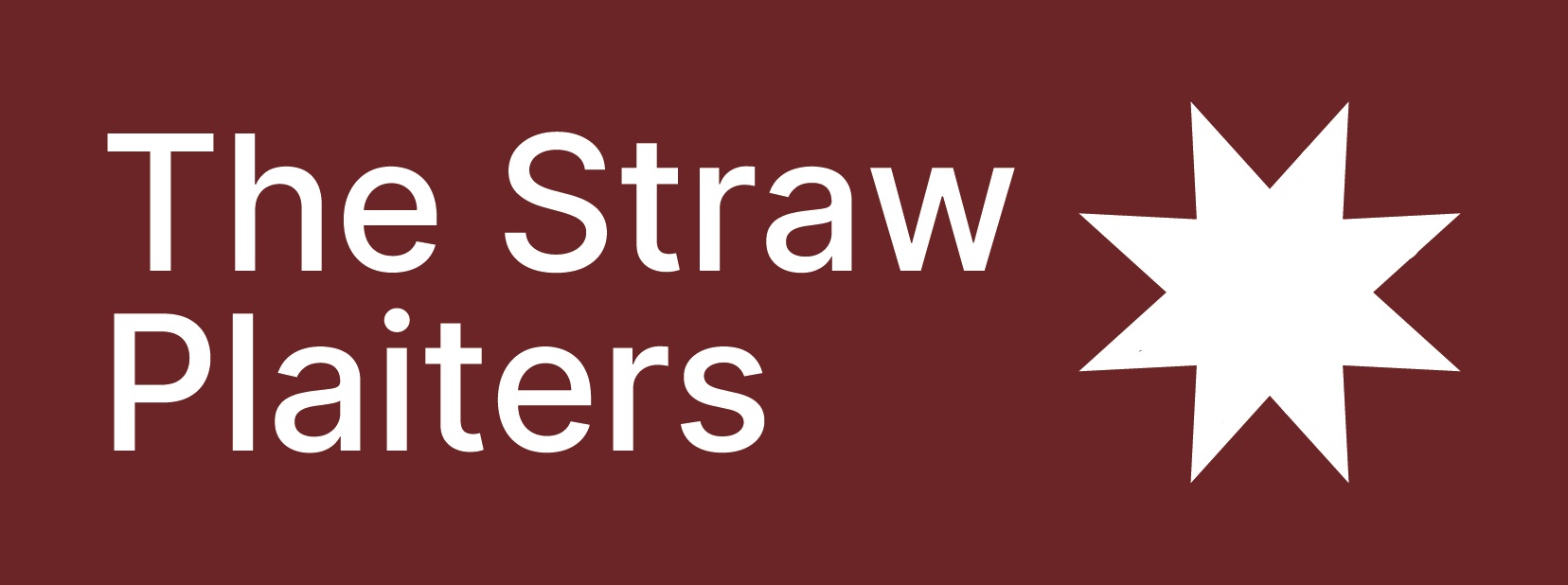CHAPTER 16 – SOME EXTREMELY PRETTY PLAY
Page 1 – Preparations
Page 2 – The first competitive victory – Reading at home
Page 3 – After the Lord Mayor’s Show
Page 4 – Chesham in the Cup
Page 5 – Chesham replay
Page 6 – Old Brightonians end the cup dreams
Page 7 – the indifferent form continues
If you just want to read the match reports then go to the pink and blue kits. If you need to catch up on Association Football rules, tactics and kits please see Chapter 8
For those who do not know “old money” – there were 12d (12 pennies) to a shilling and 20 shillings to a pound. So for example 2/4 is 2 shillings and 4d.
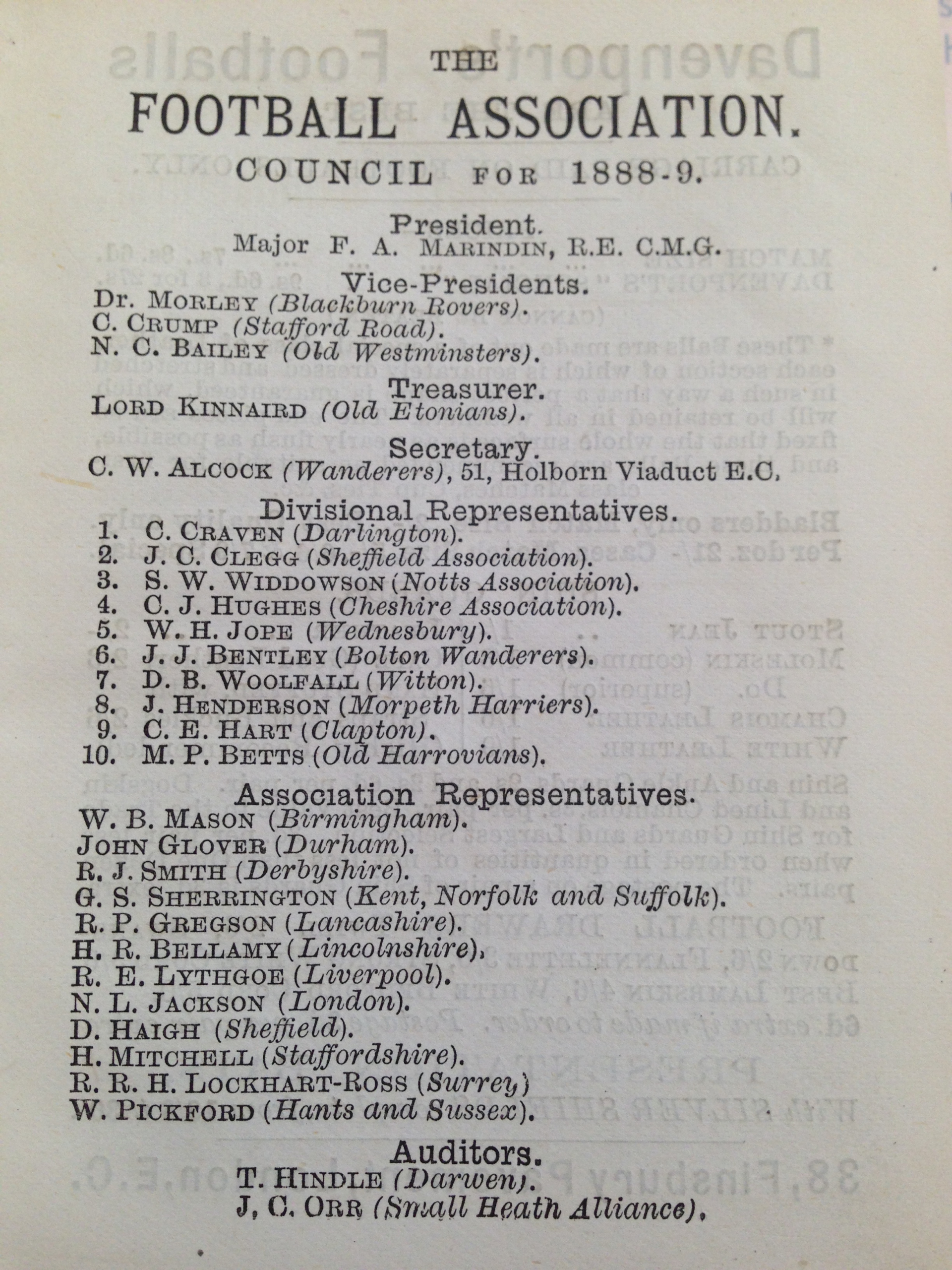
The onset of the 1888/89 season saw Luton Town without a single competitive win with only two goals scored and eleven conceded in the only cup competition entered, the F.A. Cup. Luton Wanderers had a better record in their three seasons in the F.A. Cup. The only other competition the club could have entered was the Kettering Charity Cup. That knock out competition was about to start its first season with the final being played at Kettering’s ground. The idea was that a proportion of the gate money of the semi finals and final would be donated to local causes, usually a hospital or medical institutions. People had to pay for medical treatment as there was no NHS. This was especially tough for the poor and hospitals often charged what they thought people could afford. The shortfall had to be met by other means and they relied on charitable donations to function. At a time when football was a new rough sport, this charitable attitude would help the image of the game. Some clubs were invited to compete in charity cups, others applied to enter. Usually only clubs within a radius of 30 to 40 miles of the organising town could enter. The Straw Plaiters would enter the 1889/90 Kettering Charity Cup.
The first club committee meeting of the new season took place on the 28th August 1888 at the Exchange Cafe. Frank Pitkin chaired the meeting and informed the members that he had secured the ground, Dallow Lane, for £10 for the season. Mr Barrett was confirmed “to look after the ground on the same terms as before”.
It was then
“resolved that the screens be left over until our next meeting, after the committee’s inspection of the ground”.
Dallow Lane, being a little higher than the pitch, provded a vantage point for those who did not want to pay admission to games. The club therefore decided to erect canvas screen along the Lane on match days. This is mentioned in the first hand account of attending a game, see “a fans view 1894.”
The Town had been drawn to play Reading at home in the first provisional round of the F.A. Cup. The number of entries had increased dramatically in the last few years. The first round of the previous year saw Preston North End (who lost to West Brom in the final) beat Hyde 26 0. This, and the start of the Football League, led the F.A. to introduce some preliminary rounds to weed out the weaker teams. The Straw Plaiters were in the 9th Division of the Preliminary rounds. Usually 16 teams were in each division and they played a knockout tournament with only one club advancing to the first round proper. It was therefore quite an achievement to reach the first round.
The committee provisionally picked the cup team and included some new players signing for the Town. Keives (Old Saint Paul’s), goal; D.A.N. Lomax and A. Saunders, backs; A. Taylor, A Barrett and L.C.R. Thring, half backs; J.C. Lomax, L. Narburgh, left wing; G. Deacon, E.H. Lomax, right wing; H Nolleth (Old Saint Paul’s), centre”. C. Squires of Old St. Paul’s had been elected referee which had been accepted by the Reading committee.
Locke Narburgh from St. John’s College had already played for the Town. The inclusion of two Old St. Paul’s players shows the clubs ambition but unfortunately they dropped out and did not play. The real coup was L.C.R. Thring of Wellingborough Grammar School. Luckily for the Town he beat 120 other candidates to become Head Master of Dunstable Grammar School. He was therefore nearby, able to play in the new season and had plenty of experience. Thring had played for Wellingborough Grammar School who were an excellent team and included two future international players. Another player, McFie of London Scottish, was also asked to play. After the initial excitement and promise of the first season, the next two had proved to be modest and at times slightly deflating. The club were determined to make an impact in the football world.
The first Jack the Ripper murder, of Mary Ann Nichols, was on 31st August 1888.
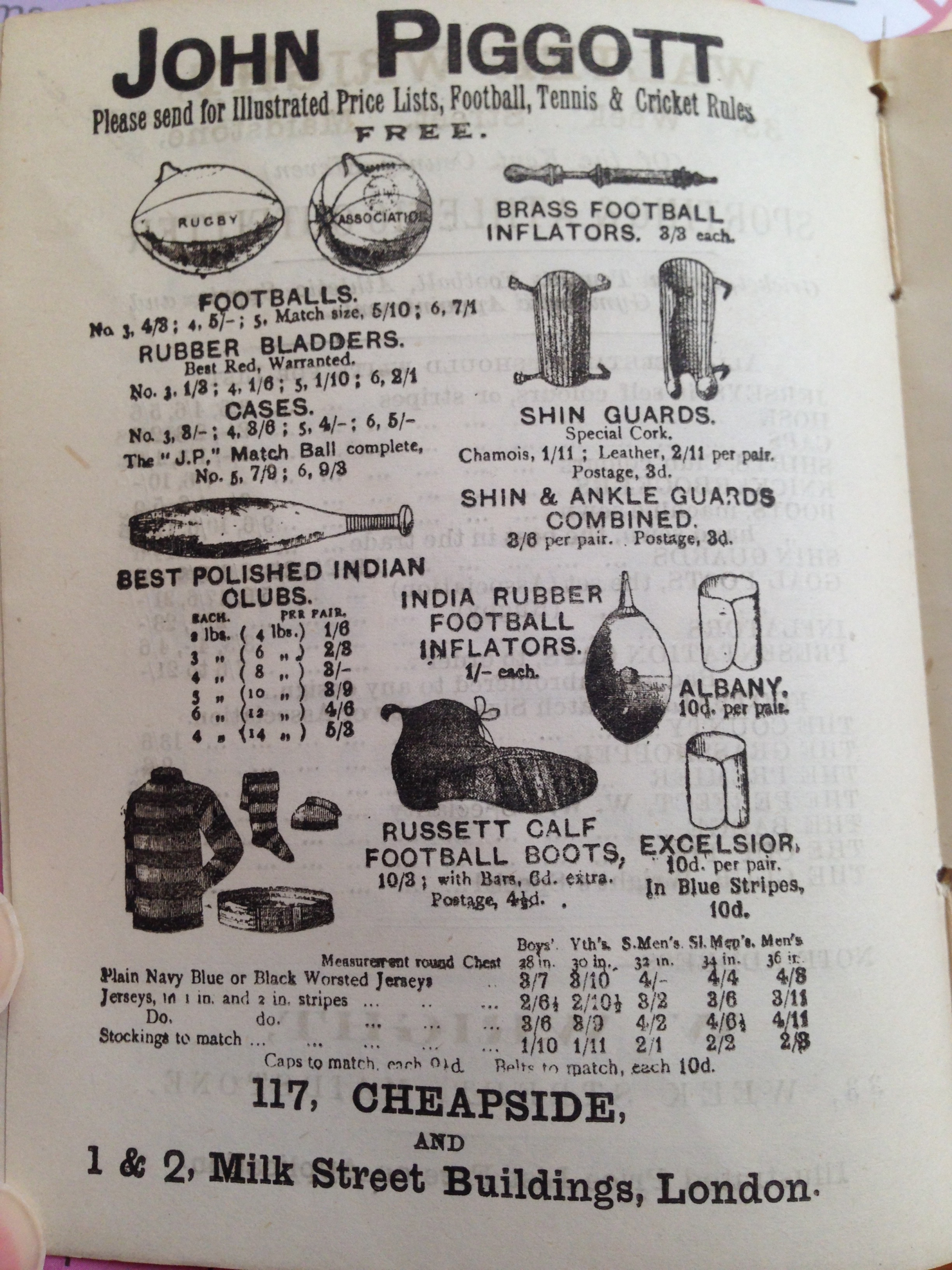
There were some more house keeping matters accounted for at the next meeting on 4th September. A ball was to be kept at the ground for “practice on the park”. New rope to go around the edge of the pitch was ordered as were “half day notices for keeping the ground clear”.
The Luton Times of 15th September reports –
“the season opened on Saturday with a trial match between the members. The teams were captained by Messrs G. Deacon and H.G. Spratley, the latter winning by 4 goals to nil, mainly through the combined play of the forwards. H. Whitby showed excellent form, and Humphrie’s back play has improved considerably since last season”.
Later that day, the 8th September 1888, the second Ripper victim, Annie Chapman was murdered.
It is interesting to see how other clubs saw the Straw Plaiters progress. Hanover United (later Polytechnic) were a strong London Club. From their in house publication “The Polytechnic Magazine” of The Polytechnic, Young Men’s Christian Institute, 309 Regent Street, London 11th September 1890 the fixture list is published.
“Clapton, Marlow, Luton Chesham and Woodville, are our strongest opponents, and if we come through evens with them we shall have reason to congratulate ourselves.”
It appears the club charged non members admission to watch the pre season practice matches as 4/8 was raised for the 15th and 2/5 for the 22nd.
_________________________________________________
Page 2
On the 25th September the committee selected the team to play against the London Scottish on the 29th. Umpire to be Mr Spratley. Umpire for Reading match, Mr Bennett.
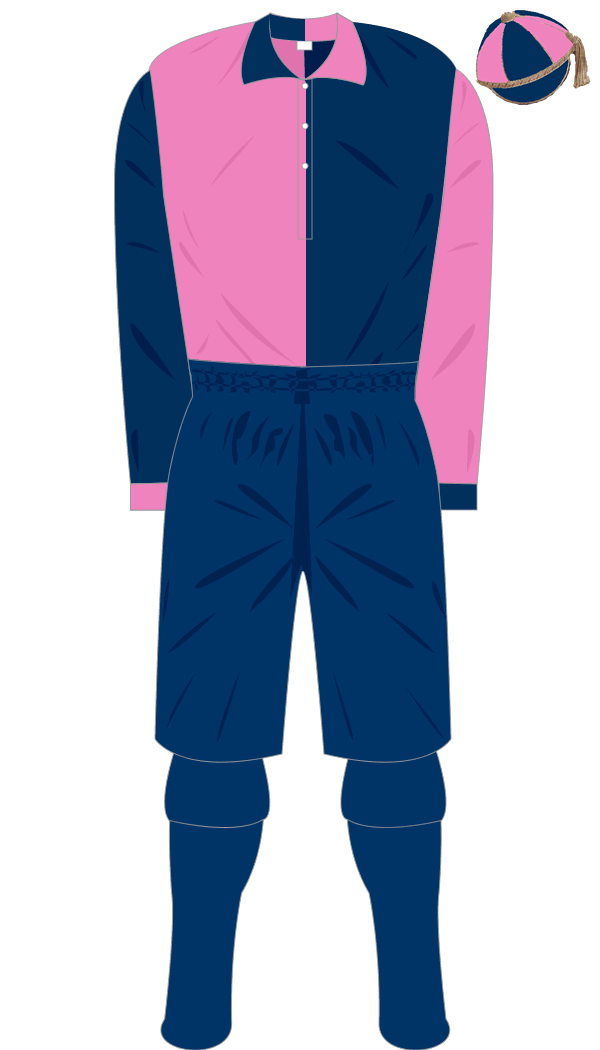
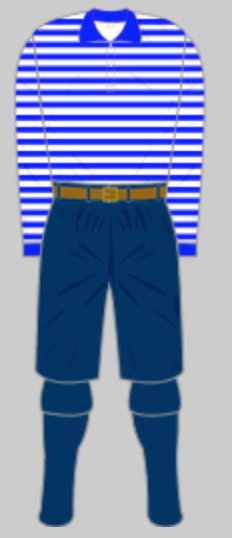 The Luton Reporter covered the game
The Luton Reporter covered the game
“The Luton Town Football Club opened the season on Saturday by playing a match on their ground in Dallow-lane against the London Scottish (late, Caledonian Swifts). The visitors arrived in Luton without their full team, but they secured the services of two Luton men, Messrs Humphrey and Spratley, both of whom did excellent services. The start was made a few minutes after 4 o’clock, and within ten minutes afterwards D.N. Lomax in his usual fine style put the leather across to the right wing, from whence it was beautifully centred, and Narburg being close up shot the sphere through the posts, thus scoring the first goal of the season. After this the ball was rolled chiefly over the Scottish ground, the passing of the Luton forwards being really fine. Again the right-wing smartly passed the ball over to the centre and Narburg (playing inner-left-wing) shot it through the goal in the same pretty manner as he had done a quarter of an hour earlier. These were the only two goals scored throughout the game, although Deacon made a fine shot , the ball hitting the uprights. Several corner kicks were well placed by E.H. Lomax and Deacon, and Barrett, half back made a tremendous kick to goal but the ball was fisted out by the keeper. The Scottish worked hard, and Spratley was within an ace of scoring at one time, but despite the efforts made, nothing more of note was done during the first half of time. Ends being changed the visitors played up considerably better, the right wing with McFie as centre frequently causing much trouble to the Town backs. The former made one especially fine shot, the ball only just passing over the cross rail. McFie made several rushes to the goal, but without the desired effect, Sanders and Mileman being on the spot for any emergency. H. Hill played well, as did Whitby and Bird. Several scrimmages occurred near the Scottish goal, the leather being kicked and tossed to one and the other until scarcely no one knew whether a goal had been scored for the Town. From about this point the players began to tire, and the game ended in favour of Luton by two goals to nil. The Luton team was ; Mileman, goal; D.N. Lomax and Sanders, backs; H. Whitby, Barrett and Bird, half backs; J.C. Lomax and Narburg, left wing; H. Hill, centre; E.H. Lomax and Deacon, right wing”.
The gate money was £2 3s 3d. Later that night, Jack the Ripper would claim more two victims, Elizabeth Stride and Catherine Eddowes.
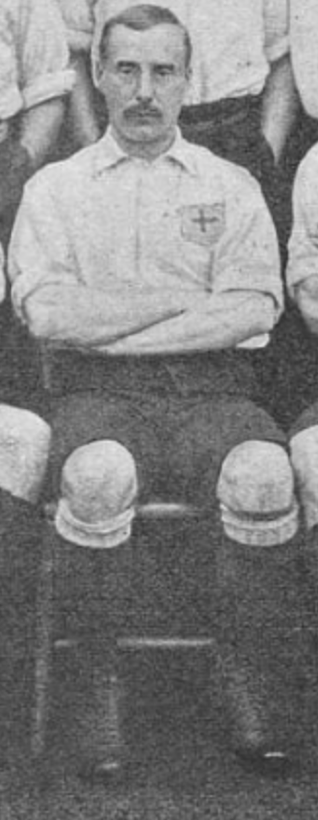 The committee meeting on the 2nd October discussed a letter from Nolloth (photo left), who had agreed to come and play in the F.A. Cup against Reading.
The committee meeting on the 2nd October discussed a letter from Nolloth (photo left), who had agreed to come and play in the F.A. Cup against Reading.
“Cup team revised, Nolloth falling out it was proposed that Thring take centre and Read half back”.
The Luton Reporter reminded its readers that:-
“The Luton Town Football Club will meet an eleven of Reading in the first round of the English Challenge cup ties. The Luton team is a thoroughly representative one, and a close contest in anticipated. We are requested to state that by order of the National Association the match must commence at three o’clock instead of half-past three, as previously announced”.

The 6th October 1888 edition of the Sporting life advertised the match above.
The Luton Reporter gives the following report –

 “The visitors, who played one man short, arrived on the ground shortly before half-past three, and were loudly applauded on entering the enclosure. They appeared to be a powerful body of men, while the home team, which was as good as could be obtained, also presented a workmanlike appearance when ranged up in their places. Directly after the start, which was made at half-past three, the home forwards obtained possession of the ball, and by some fine passing and and fast play generally the first point in the match was registered in less than two minutes from the commencement, Ernest Lomax kicking a goal for Luton amid the enthusiastic applause of the spectators. The Lutonians continued to force the play, and for some time the struggle was altogether confined to the visitors territory, the home forwards on several occasions getting into close proximity to the Reading fortress. Thring especially distinguished himself, while the brothers Lomax, Narburg and Deacon made some capital runs and “Passed” in exceptional style. The half-backs worked strenuously, Taylor being particularly conspicuous by reason of his fearless tackling and admirable “centreing”: while Sanders back play was very fine, his long kicks being sure and effective. The visitors were outmatched at all points of the game, but they struggled gamely to equalise matters, and frequently some brilliant play on the parts of their backs and forwards was witnessed. G.G. Hayward also distinguished himself. The onlookers cheered the more prominent members of both teams but the local favourites received the loudest shouts of approval. Until half-time the Reading representatives were forced to act pretty much upon the defensive. The home forwards were several times within an ace of scoring, and on three or four occasions corners were obtained after capital runs upon the wings and some admirable “passing”. Two of these opportunities for scoring were lost by ill-judged place kicking, while in a third instance the ball was kicked into the centre of the players in front of the goal but the sphere rose a foot above the cross-bar when a “shot” was made. This was, however, amply atoned for by the brilliant manner in which Narburg scored the second goal, while a third and fourth notch were added soon afterwards by Thring and J.C. Lomax, both points resulting from some extremely pretty play. So effective, indeed, was the combination of the Luton team that their citadel was not once assailed during the first part of the game, the most strenuous efforts of the visitors being defeated by the half backs and backs. On changing ends the game stood in favour of Luton by four goals to nil, and this continued to be the position at the close, for neither side scored during the second half. The home eleven again forced the play, but the game was not, as before, altogether in their favour for the Reading forwards more than once broke through and attacked the Luton goal. Their efforts were ineffective, but they were exceedingly unfortunate for one or two of their shots were admirably judged , the leather in one instance being very few inches above the post. They also secured a couple of corner kicks, the Lutonians being equally successful in this respect. Midway in the second portion of the game members of both teams seemed to relax their efforts somewhat, but towards the close the visitors recovered themselves and made strong efforts to retrieve their fortunes. This served to put the home team on their mettle, and some very fine play was thereafter witnessed, the ball travelling from end to end of the ground with astonishing rapidity. No further score was made, however, and at the call of time Luton were the winners of a well-fought game by four goals to none. The teams were as follows: Luton Town: R. Mileman, goal; A. Sanders and G. Humphrey, backs; A.H. Taylor, A. Barrett and J. Moody, half backs; G. Deacon and E.H. Lomax, right wing; L.C.R. Thring, centre; L. Narburgh and J.C. Lomax, right wing, forwards. Reading; S. Hayward, goal; Edgar Field and W. George, backs; E. Steward, G.G. Hayward and J. Collier, half backs; G. Earley, T. Skurray, E. Nailor and M.A. Harrison, forwards. Mr C. Squires (Old St. Paul’s) acted as referee while the umpires were Luton, Mr J. Bennett; Reading, Mr H.E. Walker”.
“The visitors, who played one man short, arrived on the ground shortly before half-past three, and were loudly applauded on entering the enclosure. They appeared to be a powerful body of men, while the home team, which was as good as could be obtained, also presented a workmanlike appearance when ranged up in their places. Directly after the start, which was made at half-past three, the home forwards obtained possession of the ball, and by some fine passing and and fast play generally the first point in the match was registered in less than two minutes from the commencement, Ernest Lomax kicking a goal for Luton amid the enthusiastic applause of the spectators. The Lutonians continued to force the play, and for some time the struggle was altogether confined to the visitors territory, the home forwards on several occasions getting into close proximity to the Reading fortress. Thring especially distinguished himself, while the brothers Lomax, Narburg and Deacon made some capital runs and “Passed” in exceptional style. The half-backs worked strenuously, Taylor being particularly conspicuous by reason of his fearless tackling and admirable “centreing”: while Sanders back play was very fine, his long kicks being sure and effective. The visitors were outmatched at all points of the game, but they struggled gamely to equalise matters, and frequently some brilliant play on the parts of their backs and forwards was witnessed. G.G. Hayward also distinguished himself. The onlookers cheered the more prominent members of both teams but the local favourites received the loudest shouts of approval. Until half-time the Reading representatives were forced to act pretty much upon the defensive. The home forwards were several times within an ace of scoring, and on three or four occasions corners were obtained after capital runs upon the wings and some admirable “passing”. Two of these opportunities for scoring were lost by ill-judged place kicking, while in a third instance the ball was kicked into the centre of the players in front of the goal but the sphere rose a foot above the cross-bar when a “shot” was made. This was, however, amply atoned for by the brilliant manner in which Narburg scored the second goal, while a third and fourth notch were added soon afterwards by Thring and J.C. Lomax, both points resulting from some extremely pretty play. So effective, indeed, was the combination of the Luton team that their citadel was not once assailed during the first part of the game, the most strenuous efforts of the visitors being defeated by the half backs and backs. On changing ends the game stood in favour of Luton by four goals to nil, and this continued to be the position at the close, for neither side scored during the second half. The home eleven again forced the play, but the game was not, as before, altogether in their favour for the Reading forwards more than once broke through and attacked the Luton goal. Their efforts were ineffective, but they were exceedingly unfortunate for one or two of their shots were admirably judged , the leather in one instance being very few inches above the post. They also secured a couple of corner kicks, the Lutonians being equally successful in this respect. Midway in the second portion of the game members of both teams seemed to relax their efforts somewhat, but towards the close the visitors recovered themselves and made strong efforts to retrieve their fortunes. This served to put the home team on their mettle, and some very fine play was thereafter witnessed, the ball travelling from end to end of the ground with astonishing rapidity. No further score was made, however, and at the call of time Luton were the winners of a well-fought game by four goals to none. The teams were as follows: Luton Town: R. Mileman, goal; A. Sanders and G. Humphrey, backs; A.H. Taylor, A. Barrett and J. Moody, half backs; G. Deacon and E.H. Lomax, right wing; L.C.R. Thring, centre; L. Narburgh and J.C. Lomax, right wing, forwards. Reading; S. Hayward, goal; Edgar Field and W. George, backs; E. Steward, G.G. Hayward and J. Collier, half backs; G. Earley, T. Skurray, E. Nailor and M.A. Harrison, forwards. Mr C. Squires (Old St. Paul’s) acted as referee while the umpires were Luton, Mr J. Bennett; Reading, Mr H.E. Walker”.
At this time there was no sports editorial in either of the Luton newspapers. Why did Reading only have ten men for an F.A. Cup game? It seems odd that 12 men did not travel with them as was the custom with the Straw Plaiters away games. However, it was the first competitive win for the Town. A hoodoo broken in emphatic style with “some extremely pretty play.”
The gate money for the Reading game was £8 2s 9d. The club minute book shows that the expenses for “cup tie 1st round £2 9s 6d”, and the secretary sent their portion of the gate money to Reading. The F.A. had introduced a new rule that the expenses of the away club be paid from the gate money first. The previous season Luton went to Chatham in the F.A. Cup where they lost 5 1. To rub salt into the wound, Chatham played the match in front of a huge crowd in a public park. They could not therefore charge admission so made no money and therefore could not pay the Straw Plaiters expenses. The Luton Town balance sheet showed a 5/2 loss for the season 1887/88 due to the train fares to Chatham not being paid.
___________________________________________________________________
Page 3
The club committee received a received a challenge from Norton College in Havelock Road. This was a boarding School that had been around since the 1870’s. The minutes of 9th October says –
“Resolved challenge from Norton College be accepted for 2 Wednesday matches providing they do not play any of our own members”.

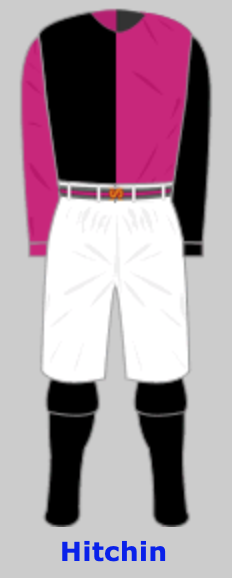 The weekend after the excitement of the cup tie Luton came down to earth with the first team losing four nil to Hitchin. The reserves played Wolverton at Dallow Lane and also lost this time by three goals to two. The general indifference of the press to the game of football and at times hostility is shown yet again by a lack of reports on either game. The Luton Times merely says the reserves fielded “a rather weak team”. The gate money for the reserve game was £1 1s 7d.
The weekend after the excitement of the cup tie Luton came down to earth with the first team losing four nil to Hitchin. The reserves played Wolverton at Dallow Lane and also lost this time by three goals to two. The general indifference of the press to the game of football and at times hostility is shown yet again by a lack of reports on either game. The Luton Times merely says the reserves fielded “a rather weak team”. The gate money for the reserve game was £1 1s 7d.
The newspapers did make the first mention of the Luton Montrose club who played St. John’s College and won a great game by three goals to two. Luton Montrose would be around for most of the Victorian era and won the first Bedfordshire Senior Cup in 1895.
The committee meeting on the 16th October selected the team to play Old St Paul’s on the 20th. Reading F.C. had acknowledged receipt of “£2 16s 6d being their portion of gate at cup tie match”.
The committee also discussed the second tie in the F.A. Cup which was away to Chesham. If I merely say that Chesham’s ground was known as “the pigs trough” you will understand why the committee offered £5 to play at Luton. The minute book says – “A discussion took place about the Chesham ground when it was resolved that we offer them the sum of £5 to play the tie on our own ground”.
The committee met two days later 18th Oct to finalise travel arrangements for the Chesham game –
“hon sec said he had seen the authorities at the station and learns that the return fare to Berkhampstead would be 2/4”
“Mr Pitkin stated that he had been to the station and found that the 8.55 am train from Luton arriving at Berkhampstead about 10 was the most convenient way of getting to Chesham thus leaving plenty of time for the team to get there by noon”.
 The 20th October 1888 saw another defeat this time at Dallow Lane to Old St. Paul’s. “Although the visitors played a fair passing game they were rough and scored two goals by rushing. Although Sanders, Moody, Deacon, Lomax and Thring played well for the Town the game ended in a two nil defeat”.
The 20th October 1888 saw another defeat this time at Dallow Lane to Old St. Paul’s. “Although the visitors played a fair passing game they were rough and scored two goals by rushing. Although Sanders, Moody, Deacon, Lomax and Thring played well for the Town the game ended in a two nil defeat”.
The Luton Times disagrees on the scoreline but adds some fascinating details about the crowd.
“The game was evenly contested throughout and although the Old St. Paul’s won by 2 goals to one, Luton played quite as good a game only they had the worst of the luck. The Old St. Paul’s played a very rough game, and at one time the spectators almost stopped the play by their hooting and dissatisfaction”.
The gate money was £2 9s 5,1/2d.
The Luton Reporter of 20th October 1888 carried the story below,
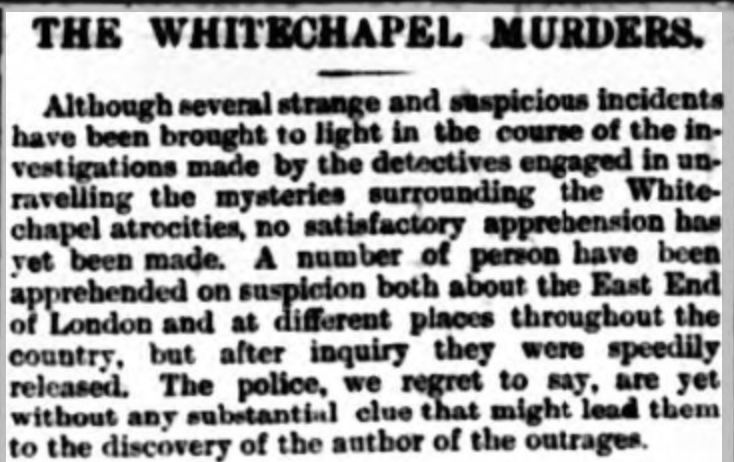
Locally, the Luton Montrose team lost to Grosvenor College at the College Recreation ground on the Winsden Hill by 4 goals to 1. Grosvenor College was the third boarding school in the town. Like Norton College (photo below) and St. John’s College they took day pupils as well as boarders. It is important to keep an eye on these local clubs as many would feed young players into the Town club. The Montrose club would prove to be a strong outfit and their side against Grosvenor contained some familiar names such as Luton players, Bert Sanders, F. Moody and Walter Miller plus Frank Hoy who would play for the reserves.
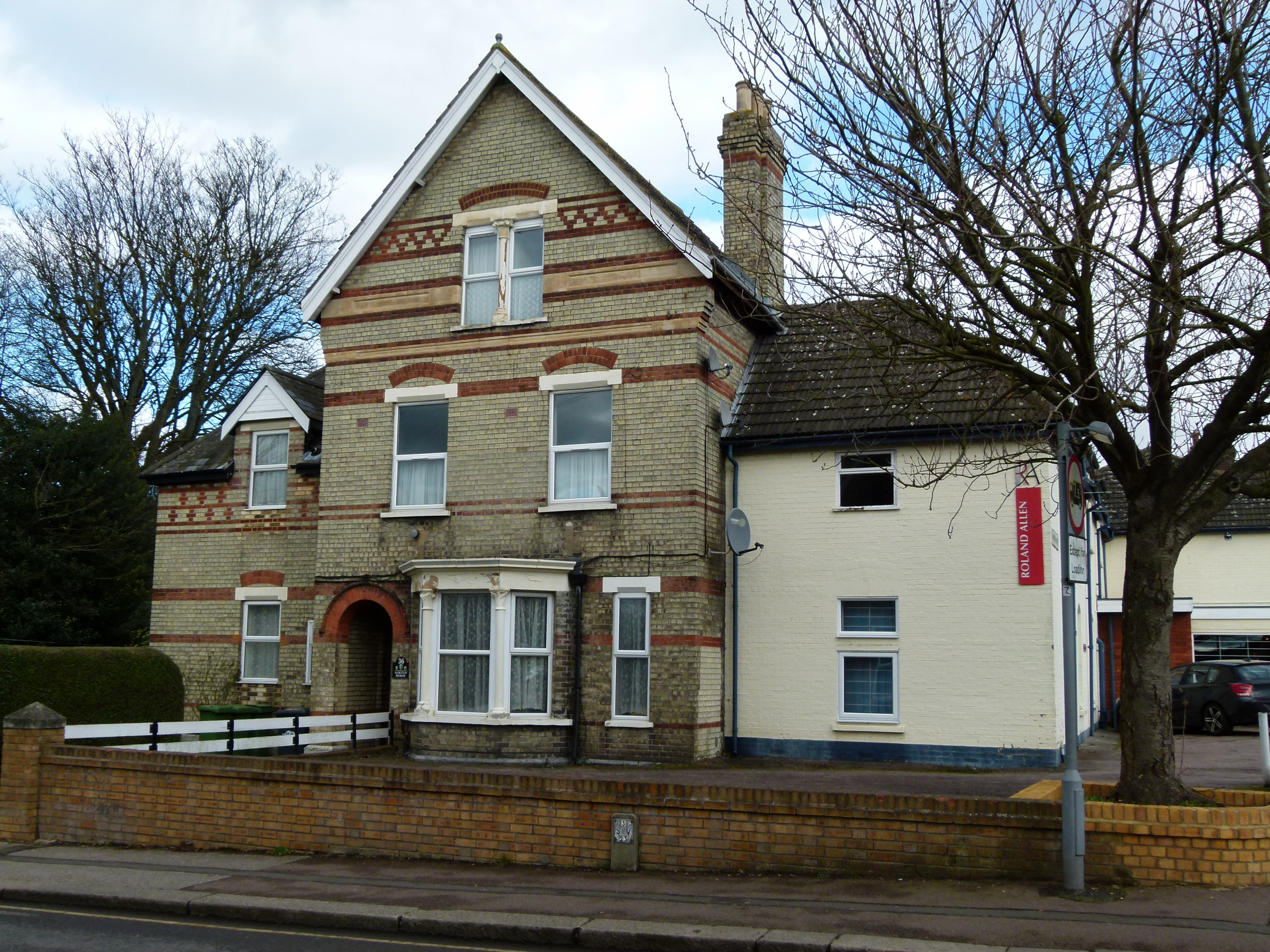
______________________________________________________________
Page 4
The editorial of the Luton Times of the 26th October 1888 may help explain the press bias against Luton Town Football Club and football in general
“Football in Luton is finding great favour with the Saturday half-holiday makers. Perhaps the brilliant sunshine of last Saturday accounted for the big “gate” when Old St. Paul’s played the Town Club. The visitors got to work smartly and scored their first goal in something under a minute from the start. I don’t understand much about the game, but it struck me that the visitors were quite rough enough, especially considering that they were not playing Rugby Rules”.
Having been against football for so long, the editor is struggling to understand the popularity of the game. He seems to be intimating that it was the nice weather that caused the large attendance at the Old St. Paul’s match, not the attraction of the game of football or loyalty to the team and town. Perhaps he was a rugby or cricket man who was upset that that form of the game had been suppressed by soccer.
The Luton Times announced that –
“the Luton Town play Chesham at Chesham on Saturday, in the 2nd round of the English cup competition. The team leave the G.N.R. (Luton) station at 8.55, and any friends wishing to go with them are requested to be at the station 15 minutes before the train starts”.
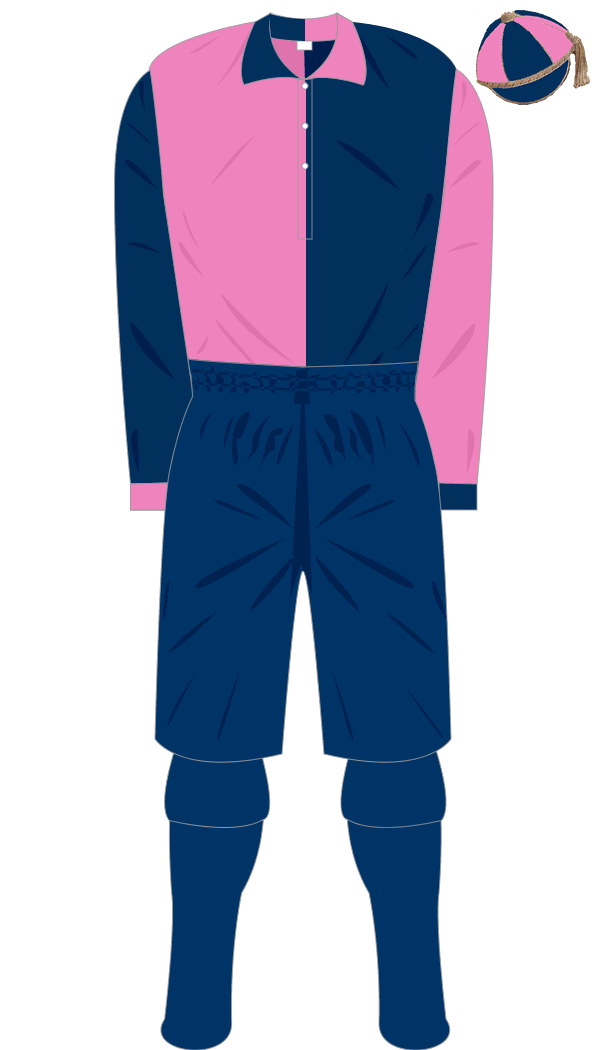
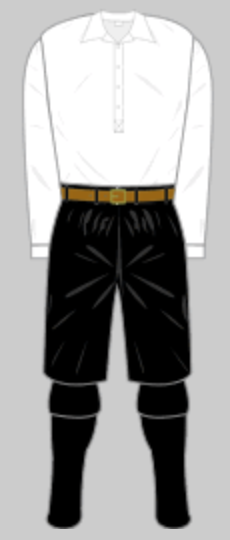 On 27th October 1888 the F.A. Cup tie against Chesham took place. The Luton Reporter says –
On 27th October 1888 the F.A. Cup tie against Chesham took place. The Luton Reporter says –
“On Saturday last a team representing the Luton Town Club journeyed to Chesham to play the local eleven in the second round of the qualifying competition for the English Association Challenge Cup and they were accompanied by a large number of enthusiastic lovers of the national game. They were favoured with brilliant weather, though a strong wind considerable interfered with the act of scoring. The home team had the advantage of knowing their ground, which is of a somewhat peculiar kind, the centre of the pitch being situated in a hollow. The Luton team was not as good as might have been, Messrs Thring, Taylor and Dan Lomax being conspicuous by their absence. The visitors won the toss and played down-hill with the wind. They pressed their opponents during the whole of the first half, and several shots were made at the Chesham goal , but these were ineffective, and when ends were changed neither side had scored. On re-starting Russell obtained the first point in the match, this being registered for Chesham, and the home team continued to press their opponents until Lewis scored a second goal for them. Luton were now put upon their mettle, and played with great determination they succeeded in equalising matters before the call of time, Narburg and C. Lomax scoring, the second notch being registered about a minute before time was called. Lewis, the Chesham centre forward , had in the meantime been hurt, and had retired from the field. An extra half hour was played, and Lomax scored for Luton amidst intense excitement, and the Cheshamites evinced great enthusiasm when a further goal was obtained by the home eleven from a free kick, the ball striking Mileman’s toe, thus equalising the scores. In consequence of the match resulting in this way, the Chesham team will have to come to Luton to-morrow (Saturday), when the match will be replayed on the Dallow-lane ground. Play will commence by special order at 2.30. The teams were as follows:- Luton; R. Mileman, goal; A. Sanders and G. Humphrey, backs; T. Read, A. Barrett and J. Moody, half backs; G. Deacon, E.H. Lomax, LC.W. Thring, L. Narburg and J.C. Lomax, forwards. Chesham; F. Sills, goal; A. Hobbs and A. Ruggins, backs; G. Payne, J. Bryant and H. Rose, half backs; J. Culverhouse and W. Sear, right wing; E. Russell and W, Brandon, left wing; F. Lewis, centre, forwards. Umpires; Messrs T. Hayley and F. Scott. Referee; Mr J. Henderson (Morpeth H.)”.
The Luton Times said –
“This tie was played at Chesham on Saturday, before a large number of spectators , including a good number from Luton. The Luton team was not so strong as was advertised to play, A. Taylor and L.C.R. Thring being unable to be present. The match was played on a peculiar piece of ground; the goal posts were in a valley and the ground rose on both sides of them and the corner flags were much higher than the tops of the goal-posts. The home team played up hill against the wind in the first half and managed to keep the Luton team from scoring, and at half-time neither team had scored. When ends were changed the home team, with the wind in their favour, came away with a rush and soon managed to score, and about ten minutes afterwards rushed another. Matters now looked rather bad for Luton, with two goals against them and only 10 minutes to play; but they put themselves together and commenced to play in real earnest and although the wind was dead against them, they shot the ball through, and 1 1/2 minutes from time scored agains thus making it even. The referee now ordered the teams to play another quarter each way, and the Luton rushed another goal in a few minutes and had several narrow escapes for others but had no luck, and at a few minutes from time, the Cheshamites had almost given up all hopes, when a free kick was given against Luton and the ball went through off one of the tracks, thus making the game even again. The teams have been ordered by the Association to play off the tie on the Luton ground on Saturday, when Luton will be strongly represented, and is expected to win, so as to meet the Old Brightonians in the Dallow-lane the following Saturday”.
The meadow used by Chesham was rented from a local farmer and due to the contours it was know locally as the “pig trough” – no wonder Luton tried to move the game to Dallow lane.
The editorial of the Luton Reporter made a rare comment upon football in its 3rd November edition. Did it comment on the entertaining three all draw and magic of the cup? Of course not. It seized on a kick in the groin in a predictably attack on the game.
“What people are accustomed to call the “manly” game of football is in great danger of being accurately described by another, and totally different adjective. The season is again in full swing , and every Saturday, which is sacred to matches, brings its crop of casualties. Last week’s list was pretty complete – a broken leg at Bradford, a fractured collar bone at Maidenhead, another accident of the same kind at Lytham, while at Chesham, where the Luton Town engaged the local champions, one of the Chesham’s team’s best men was disabled by a severe kick to the groin. Then there have to be added the numberless mishaps of a minor nature such as players stunned and carried off the field, or kicked, scratched, or bruised, and other incidents that are never chronicled. “Play football by all means my boys” exclaims John Bull in the pages of Punch this week, “but don’t let it be this brutal sort of thing” – pointing to a scrimmage of the kind that is now only too common. There is no other English sport or game in which accidents are half so numerous or so serious as in football. This is a reputation that will soon have its effect. It is quite time that even the association rules were revised and humanised”.
The newspapers might have a point as changes were brought about to the game in 1892 when Lord Kinnaird became President of the F.A. However, having seen the John Bull cartoon, it clearly refers to Rugby Football which indicates the Editor was clueless.
 On the same day that the first team played at Chesham, the reserves met Limehouse in Dallow Lane when;
On the same day that the first team played at Chesham, the reserves met Limehouse in Dallow Lane when;
“the elevens were evenly matched. The visitors’ weakest points were the left wing and right half backs. The backs were in good form. The goal keeper (Deal) saved admirably some excellent shots during the first half; Martin and Hoy (Backs) played in their usual good style as did the half backs (Munro, Garrett and S. Wright), whose tackling and passing could be but little improved upon. Miller and G. Smith (left wing), H. Whitby and Smart (right wing) showed up in a creditable manner. Spratley (centre) frequently had little to do – which is somewhat unusual – but the work that fell to him he did in his accustomed style, scoring a goal, while Whitby got one, Smith one and Miller obtained two. The game ended five goals to one”.
The gate money was 19/2.
The following Wednesday the reserves played against Norton College F.C. again at Dallow Lane and won “somewhat easily” by 6 goals to nil.
The club committee met on the 30th October and discovered another serious loss. The club’s portion of the gate money from Chesham was £1 11s 6d. “Expenses of team for cup tie second round £3 4s 0d”.
The expenses for the team seems very high. We know the train fare per person for Chesham was 2/4 to Berkhamstead. If 11 players plus the Secretary/Umpire made the journey that makes 12 people at 2/4 each makes 28s. Then presumably the team took a break (horse drawn coach) from there to Chesham, a distance of 5 miles. A previous trip by trap from Hemel Hempstead to Harpenden had been 6s for the ten mile journey. Therefore, the hire of the break to Chesham must have been around 7s each way leaving a balance of £1 2s. What was that money spent on? We know that refreshments are provided by the home team. The cost of the referee and linesmen were met by Chesham before dividing the gate money. Even if we say that another two committee members went to the game courtesy of the club then we still have a balance unaccounted for. Were the club meeting the expenses of the players lost wages at this time? Maybe.
_______________________________________________________________
Page 5

 On 3rd November 1888 the replay with Chesham took place.
On 3rd November 1888 the replay with Chesham took place.
“On Saturday last the tie in the second round of the qualifying competition for the English Association Challenge Cup between Luton Town and Chesham, which ended up the previous week at Chesham in a drawn game of three goals each, was replayed in the Dallow-lane ground. The weather was of the most unfavourable nature, rain falling in drenching showers during the day. The ground was in consequence in extremely bad condition, the rain having saturated the turf and rendered it exceedingly slippery. Despite the uninviting nature of the atmospheric conditions a large crowd of spectators assembled to witness the game, indeed it seemed that at one period there could not be less than a thousand persons on the ground. The teams had been little changed since since the drawn game was played, but the changes were all in favour of Luton. Messrs L.C.R. Thring, A. Taylor and D.A.N. Lomax had not been included in the team which represented Luton Town at Chesham, but these prominent players all occupied places in the home eleven on Saturday, while the visitors were deprived of the services of F. Lewis, their centre forward, who was somewhat badly injured during the progress of the first match at Chesham. The visitors were in this respect somewhat handicapped, but it would be unfair to the home team to assert that this would altogether account for the result, this being in favour of Luton by ten goals to two. The match had been announced to commence at half past two, but the late arrival of the referee prevented a start until half an hour later. Chesham had won the toss, and shortly after three o’clock Thring kicked off for the home team. The Luton forwards at once showed that they were in fine form, for, although they had during the first half to play up-hill, some capital play resulted in the Chesham goal being attacked almost immediately after the commencement. Soon afterwards the ball was returned into close proximity to the home fortress, and one of the Luton players “fouled” a Chesham back, whereupon a free kick was granted to the visitors but nothing resulted. Give and take play followed, a very fine run by Narburgh and J.C. Lomax ending in a “corner” for the home eleven, while Chesham subsequently gained a similar advantage. The ball was centred but Deacon obtained possession of the sphere and ran down the field in capital style, and subsequently “passing” to Narburgh, who made a splendid shot which went just over the top of the posts. Similar tactics by the same players were afterwards pursued, though the attempt to score was frustrated by the alertness of the Chesham custodian, who was defending his charge in good style. Hereabouts some excellent play on the part of the visitors’ forwards terminated in a hot shot being made at the home fortress, but Mileman succeeded in keeping out the leather. The game was for some time now was all in favour of Luton, who obtained a corner, and made some strenuous attacks upon the Chesham uprights, but the first point in the match was scored for the visitors’ in a rather peculiar manner. A free kick for “hands” had been taken, and D.A.N. Lomax was endeavouring to keep the sphere away from the front of the Luton goal by a heavy kick, when the ball, which was soaked with the rain and was extremely slippery, flew off the side of his foot through the posts. This was the first goal registered by a Luton man for the opponents. The supporters of the Chesham team who had congregated in good numbers in one part of the ground, here set up a tremendous cheer, and continued their enthusiastic shouting for a considerable time. Things now began to look very bad for the home eleven , but the whole of the team played with pluck and determination and in a very short time they scored to equalise. Narburgh kicking a goal in the course of a scrimmage. The Lutonians continued to press their opponents, and before half-time two more points were obtained, Deacon and Narburgh scoring them. This score thus when half time arrived was thus Luton 3 goals to Chesham 1. During the second part of the game the play was confined almost entirely to the Chesham territory and their fortress was incessantly assaulted. Goals were obtained in rapid succession, and it soon became apparent that the chances of the visitors appearing in the third round were worse than doubtful. Chesham obtained a second point in good style, while Luton added seven notches to their total, these being obtained as follows: Thring, 3; J.C. Lomax, 2; Narburgh, 1; Deacon 1. The home eleven played in capital style throughout the whole game, their tackling and passing being very fine. It would be unfair, perhaps, to particularise when all played well, but it must be stated that D.A.N. Lomax, who has not played here for some time, particularly distinguished himself among the half-backs, and it seemed that he was a host in himself. By their victory in the second round the Luton team have qualified themselves to enter the third round and they will accordingly measure themselves against the Old Brightonians on the Dallow-lane ground on Saturday next (Nov.17). The teams on Saturday were as follows – Luton: R. Mileman, goal; A. Sanders and G. Humphrey, backs; D.A.N. Lomax, A. Barrett and A.H. Taylor, half backs; L.C.R. Thring, centre; G. Deacon and E.H. Lomax, right wing; L. Narburgh and J.C. Lomax, left wing, forwards. Chesham. F. Sills, goal; A. Hobbs and A. Huggins, backs; G. Payne, J.Bryant and H. Rose, half backs; S. Harris, centre; J. Culverhouse and W. Sear, right, R. Russell and W. Brandon, left wing. The umpires were Messrs T. Bayley (Chesham) and J. Bennett (Luton), whilst the referee was Mr M.F. Batts (of the Old Harrovians).
The Luton Times also gave excellent coverage.
“This undecided tie was played off on Saturday last on the ground of the former club in Dallow-lane, Luton, in miserable weather, rain falling the whole of the time. But, notwithstanding the elements, there were nearly 1,000 people to witness the game including about 100 Cheshamites who distinguished themselves by shouting and hooting until the match was finished when they went home “with their combs cut”. The game was advertised to start at 2.30, but was delayed owing to the late arrival of the referee, Mr M.P. Betts of the Old Harrovians. Chesham won the toss, and elected to play from the Dallow-lane goal. Thring started the ball for Luton, and it was taken up the field and a start made for goal by Narburgh, but the ball went behind. From this kick out the ball was taken up the field by the Chesham forwards , and a free kick was given against Luton close to their own goal, and from it the first goal of the match was scored by Chesham, the ball going through off Dan Lomax. Luton, stimulated by this disaster, now began to wake up and commenced to play in real earnest, and from this time Chesham never had another “look in.” Luton overmatching them at all points, and scoring goal after goal until they had got half a score and would no doubt have got considerably more if the day had been fine. About two minutes from time, a little excitement was created amongst the Chesham supporters by their players scoring a flukey goal, Mileman letting it in owing to the darkness. After this lesson, it is unlikely that the Cheshamites will ever again entertain the idea that they can beat Luton. The home team were much stronger than the one which played at Chesham the previous week, while the Cheshamites were minus Lewis, who was injured in the first match. The Luton men played well all round, Thring, Narburgh, Mileman and Lomax specially distinguishing themselves, the passing of Thring and Narburgh being excellent, while Deacon also put in some capital work”.
The teams are then given and the report ends with,
“The semi-final in the competition for this division will be played on the 17th inst. When the Luton men meet the Old Brightonians in the Dallow-lane ground”.
Two comical goals conceded but a terrific 10 2 victory against a good team. Hat tricks by Thring and Narburgh and a marvellous performance. So much so that a letter was written and published by the Luton Reporter of the 10th November –
“Sir – No one was more delighted last Saturday than myself so see our local team lower the colours of the Chesham team in the way they did. By this victory Luton will have to meet the Old Brightonians in Dallow-lane. All these Cup Tie Matches must necessarily mean increased income to the Club, especially as they have had to play three (and let’s hope will have a fourth) of them on their own ground. Now granting passable weather, and judging by the hundreds present last Saturday, notwithstanding the drenching rain, will there not be a very great crowd of spectators present on the 17th inst. May I suggest that the Club committee will agree to give (after paying the “Old Boys” their share) some part of their “gate” to the Luton Supplementary Relief Committee? Winter is drawing apace, and doubtless funds will be urgently needed by that well deserving body. If this were agreed to and stated on their posters, I am convinced that many who are now uninterested would show a desire to add in the cheers on that auspicious occasion. Hoping that the Luton team will give the Brightonians a “taste of Chesham”, I am, sir, yours truly,
Enthusiast,
Nov 6”.
The committee meeting on the 6th November shows a breakdown of the Chesham figures .
“Gate money for nov 3rd Cup tie second round £6 10s 4d, expenses were £2 2s 0d including 13/6 for referee. Therefore the profit for Chesham was £2 4s 0d”.
The Luton Reporter editorial had not been forgotten by the committee as the minute book says that
“A discussion then took place with reference to a leading article respecting our Football Club which appeared in the Reporter of the previous week. After which, it was proposed by Mr Bennett, seconded by Mr Carter, that seeing that the Reporter is very fond of issuing misleading statements with respect to our club (the printing to be taken from the Reporter and entrusted to Mr Atkins for a time)”.
INTERLUDE – The Luton Reporter covered a meeting of the Board of Guardians of the Luton Union. Mr Cook made a speech – “He had pleasure in asking them to join with him in drinking to the health of the Queen, though for the life of him, he said, he could not understand why they should have a lady to reign over them and not permit ladies to vote (laughter). That was a thing which no fellow could understand (renewed laughter).
Friday 9th November, Mary Jane Kelly, the last of Jack the Ripper’s known victims was found.
The Luton Reporter publshed the reply to “Enthusiasts” letter.
“Sir, Your last weeks correspondent “Enthusiast’s” suggestion that the Committee of this Club might give some part of their “gate” after paying our opponents their share might, upon the face of it, appear to the outside public nothing more than they would do , in order to help the very needful and deserving funds of the Luton Supplementary Relief Committee. But of “Enthusiast” had taken the trouble before writing to inquire of the officials of this Club, he could have been satisfied beyond doubt that after deducting the actual expenses incurred by the Club in the previous matches in connection with the qualifying round of the English Challenge Cup of this division, they are but very few shillings to the good. I might add that if the “Old Brightonians” would be willing to forego their portion of the “gate” after deducting the actual out of pocket expenses, I have every reason to believe the Town Football Club Committee would be equally willing to hand over their share to the Supplementary Relief Committee, without the slightest hesitation.-
Yours Truly,
A member of the Luton Town Football Club Committee,
Nov 15th 1888”.

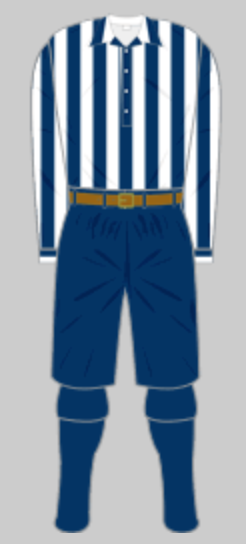 The Luton Times concentrated on a win the the Town against Tottenham Hotspur on 10th November 1888.
The Luton Times concentrated on a win the the Town against Tottenham Hotspur on 10th November 1888.
“Played on the club ground, Dallow-lane, Luton, on Saturday last. Luton did not play their best team, playing neither Taylor, Thring, Narburgh, nor the brothers Lomax. The teams were about evenly matched and a fairly good game, but very slow, ensued. The forwards on neither side played a passing game but all played for themselves instead of to the rest of the forwards. Play was not begun until 3.30, and it was nearly dark before the finish, Luton winning an uninteresting game by two goals to nil”. It continues “The Luton team meet the Old Brightonians in the semi-final tie for the district to-morrow (Saturday) in the Dallow-lane, play to commence at 2.30. Luton will be represented by Mileman, Sanders, Humphrey, Barrett, Taylor, D.A.N. Lomax, J.C. Lomax, E.H. Lomax, F. Narburgh, L.C.R. Thring and G. Deacon: umpire J. Bennett; referee J. Armstrong”.
The gate money was was £1 12s 3d
___________________________________________________________________
Page 6
The committee met on the 13th November and picked the same team for the 3rd round of the cup. Also “resolved that ground be rolled according to the instructions of Hon Sec before the Cup Tie”.

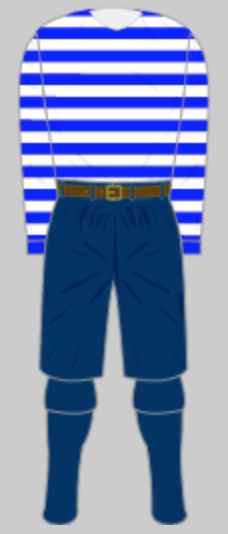 On 17th November 1888 Luton v Old Brightonians –
On 17th November 1888 Luton v Old Brightonians –
“on Saturday last on the Dallow lane ground the Luton Town Football club met the Old Brightonians in the third round of the qualifying competition fro the English Association Challenge Cup. The weather was fine, but an extremely high wind prevented really first-class play. There was a large crowd of spectators: Indeed it is stated that Saturday’s attendance constituted a “record” in this direction. The home team won the toss, and elected to play up-hill with the wind. The Old Brightonians kicked off shortly after half past two, and it soon became apparent that they were the best team that Luton had yet met in the cup competition. The home team pressed for some time, and obtained three corners in rapid succession, Dan Lomax kicking two of these in capital style, the ball dropping just in front of the visitors’ goal. The shots were ineffectual, while a shot by the Old Brightonians at the home fortress was also without effect, the leather being fisted out by Mileman. After good play on both sides, Luton obtained the first goal, the notch being scored by Deacon, who was playing hereabouts in a highly satisfactory manner. Just before half-time the visitors’ forwards had a splendid run and succeeded in eluding the vigilance of the Luton goal-keeper. The home team appealed on the ground of “offside” but the referee decided in favour of the visitors, and a point was consequently recorded in their favour. Immediately after restarting, the Brighton eleven scored a second goal, thus obtaining the lead. The home team were now playing against the wind, and struggled gamely to retrieve their fortunes, but their most strenuous efforts were ineffectual. As the time grew nigh when the game must finish both elevens played up in grand style, and for some time it seemed that Luton would succeed in equalising, but despite their admirable play the visitors were enabled to defend their citadel, while they added a third goal about five minutes before time, thus placing the issue beyond doubt. At the call of time the visitors were victorious by three goals to one. the result was due in great measure to the excellent passing and fine combination of the Brightonians, the whole of the members of their team showing up prominently. The members of the home eleven played in capital style, all of them being conspicuous at some period of the match. The teams were as follows: – Luton: R. Mileman, goal; A. Sanders and G. Humphrey, backs; D.A.N. Lomax, A.H. Taylor and A. Barrett, half backs; G. Deacon and E.H. Lomax, right wing; L.C.R. Thring, centre; L. Narburgh and J.C. Lomax, left wing, forwards. Old Brightonians: A.C.S. Stone, goal; J.P. Muspratt and A.T. Hay, backs; W.W. Eggar, F.P. Lingard and E. Tudor-Jones, half backs; G.L. Wilson, and J.H. Bennett, left wing; W.G. Bond, centre; H.A. Harrison and C. Simmons, right wing, forwards. Umpires: Messrs J. Bennett (Luton) and W. Leete (Old Brightonians). Referee: Mr J. Armstrong”.
Lingard and Wilson had represented the “South” against the “North” so should be considered as players on the fringes of international football.
The gate money taken for cup tie was £13 9s 0d. Expenses were £3 9s 0d. Brightonians portion was £5.
The Luton Times had an equally lengthy report –
“On Saturday afternoon a match in the Association Challenge Cup district ties came off in the Dallow-lane between Luton Town and the Old Brightonians. There were some 2,000 spectators present. The weather was fine, but a high wind blew across the field, so that the ball was frequently outside. The visitors were a much heavier team than the home men, who were of course at a disadvantage here. The Luton eleven is notably a light one, and yet they score well against more solid clubs. It was a well contested game, and resulted in a win by the Old Brightonians by three to one. The visitors spoke in very commendatory terms of the fairness of the Luton team and of the onlookers. There were at least four goals all but won by the home team, and they fought pluckily through the game. The first goal was got for Luton by Thring, who ran the ball down the field and passed it to Deacon, who shot it through. At half-time each side had secured a goal, the Brightonians having gained theirs by a rapid rush through the field in which some excellent passing play was displayed. Five minutes later the visitors obtained their second goal. J.C. Lomax took another goal for Luton, but it was given off-side, though it did not appear to be so to many of the spectators. Several other efforts were made to bring the score level, but five minutes before time the Brightonians gained another point, and the game ended with a score of 3 to1. A letter was written to the Times by “one of the crowd”. ‘I am quite a novice with regard to football, but like many others who witnessed the interesting match last Saturday, I am an excited and enthusiastic onlooker, and look forward to our town producing a team which will be able to compete successfully with such athletes as the Old Brightonians; but the time is not yet. Such specimens as the OB’s are not, reared in a year or two. They doubtless, were kicking a ball about at the early age of six – a time when football in Luton was in its first childhood. We must, I suppose, wait patiently until our “fourteen-year-olds” have arrived at early manhood, and had the benefit of the good training they seem to get nowadays, before we can reasonably hope that our town team can enter the lists with a decent chance of bringing off an Association Challenge Cup. Footballers in Luton have much to thank the Lomax Bros. for; but, now that their services are not always available, it is only right that our own town team proper should play constantly together, and not depend too much upon members at a distance. The “special team” as at present constituted has too much of the chance element about it. I should have wished to see more good matches down in the “fixtures” for this season; more would be learned by our men from the first-class players – “the greater the odds, the greater the glory” and with the townspeople the greater would be the attraction and consequent addition to the funds. The Lutonians doubtless had very hard work last week, but evidently the better team won. The visitors had the best of it in terms to physique. I never saw a finer lot of fellows; their passing was splendid; and their tactics and combination excellent. The deliberate way in which they played and the exactitude with which the ball was kicked from one to the other won general admiration’ ”.
That letter was not written by a football novice. He had knowledge of tactics and “combination” play. A knowledge that the fixtures had been weak for a while and that the players had not been learning was the opinion of a seasoned supporter. It was also true of the Lomax brothers. The Town were usually much weaker when they did not play and they could not always be relied on to play and even appeared for St. Albans on occasions. Dan was in the army so was restricted but J.C and E.H. do not seem to have had any excuses as they were “gentlemen” living off their father’s wealth. It may be that the Lomax brothers had a head start in football. They came from Lancashire, the hotbed of football, and may have been kicking a ball from a young age while the children of Luton were largely ignorant of the game until 1885. Perhaps the brothers learned skills and tactics which gave them an advantage when they came to St. John’s College. There they would have met like minded lads who came from all over the empire. They were just as fit as the local men and had probably been better fed than their working class counterparts which gave the College an edge in sports.
While Luton lost to the Old Brightonians, St. John’s College played Ashton Grammar School with E.H. Wright and H. Berridge at backs, A. Kershaw and A.L. Delaforce at half backs, J.R. Benavides and W. Berridge played right wing. Edgar Wright and Jose Benavides had played for the Town. Add in the current players, Locke Narburgh and the Lomax brothers, and we see what a great service the college did for the club.
 On Wednesday 21st November the reserves saw action –
On Wednesday 21st November the reserves saw action –
“Grosvenor College v Luton Town. These teams met in Dallow Lane on Wednesday. Rain was falling all the time, and in the second half there was quite a downpour, the state of the ground thus rendering play almost impossible, the players slipping at nearly every attempt to kick. The Town men put in three goals during the first half, the college several times also very near scoring. On change of ends, the play was chiefly in town territory, the Grosvenors sending in several shots causing Read, the goal keeper, to use his hands. The town increased their goals to four and the College failing to score, the game ended in a win for the town by four goals to nil. The following were the teams: – Grosvenor College: G. Ford, goal; W. King and A. Colling, backs; G. Cornery, H. Arnold and A. Clarke, half backs; E.E. Arnold, centre; W. Waller and A. Smart, right wing; A. Arnold and C. Colling, left wing, forwards. Luton Town: Read, goal; A. Sanders and Hoy, backs; Wright, Munroe and Hills, half backs; H.G. Spratley, centre; T. Small and W. Miller, left wing; W. Wheeler and Boxford, right wing, forwards”.
Two future Luton players, King and Colling, were in the Grosvenor side.
 On Saturday 24th Luton Town played Bedford at home. The Luton Times says that
On Saturday 24th Luton Town played Bedford at home. The Luton Times says that
“Luton was strongly represented, and a very good game was the result, considering the wind which was blowing hard throughout the game. Luton had the best of the game throughout, and won by 2 goals to nil. Clarke, who was tried at back, in place of Humphrey who is ill, played a very good game and another goal keeper was tried, but he did not have anything to do. On Saturday the Millwall Rovers, the holders of the East End Cup, come to Luton to try conclusions with the local team. L.C. Fernie, the international half-back is expected to play for Luton”.
The gate money was £1 1s 11d.
__________________________________________________________________
Page 7
The committee met on the 27th November to select the team to play Millwall Rovers on 1st December.

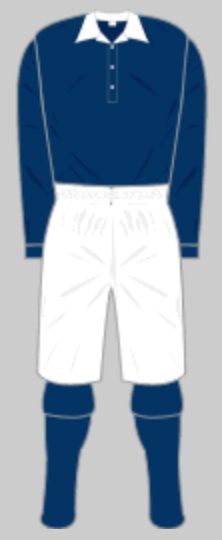 On 1st December 1888 Luton Town v Millwall Rovers.
On 1st December 1888 Luton Town v Millwall Rovers.
“This match was played in the Dallow-lane, on Saturday. Owing to the late arrival of the visitors the match did not start until 3.30. The Rovers, who are the holders of the East-end of London Cup, came down 3 men short, and had to obtain substitutes on the field. Luton kicked off with the sun at their backs, and at once commenced to press and after playing about 10 minutes, Deacon scored the first goal for Luton. No other point was scored before the expiration of the first 25 minutes, when the teams crossed over with the game on goal in favour of the home team. Both teams played up well in the second half, McFie putting in some good runs for the Rovers, but the Luton goal was kept intact by the good play of the backs and goalkeeper. The Luton forwards were now playing a good passing game, and a hot shot was sent in by Small which the custodian muffed, and before he could get back to his charge, Thring rushed up and kept him off while the ball rolled through the goal. The Rovers kicked off but the ball was at once returned by the local backs, and Miller now made himself conspicuous by a splendid run which he ended by sending in a clinking shot that completely baffled the goal keeper, thus scoring the third goal for Luton. The whistle was blown for time shortly after leaving Luton the winner of a pleasant game game by three goals to nil. The Luton team was as follows; Read (goalkeeper), E. Clarke, A. Sanders, C. Munroe, T. Wright, A. Moody, G. Deacon, H. Whitby, L.C.R.Thring, G.H. Small and W. Miller: umpire J. Bennett”.
Thring knew the laws well and presumably barged the goalkeeper thus preventing him from diving on the ball as it trickled towards the goal line. Barging the keeper when they did not have the ball was not outlawed until 1894. J.C. Lomax decided to play for Chesham at Reading instead of the Straw Plaiters. His team suffered a 6 0 defeat (taken from the Reading Mercury of 8th December 1888).
The gate money was £1 19s 4d.
Locally, Grosvenor College beat Caddington 10 1 on the College recreation ground on the Winsden Hills”. Luton Montrose drew one all at Hitchin. The Ashton Club beat W. Garrett’s eleven of High Town 4 0. Montrose second eleven beat Excelsior 4 0. See the “Monts” advert below published in the Sporting Life on the 6th December 1888. This type of advert was useless for new clubs to find opponents. It also helped find aooponents at short notice if a date became available.

INTERLUDE – The Luton Reporter covered a fire in its 8th December 1888 edition. The Fire Station, photos below, in Church Street was built in 1876.
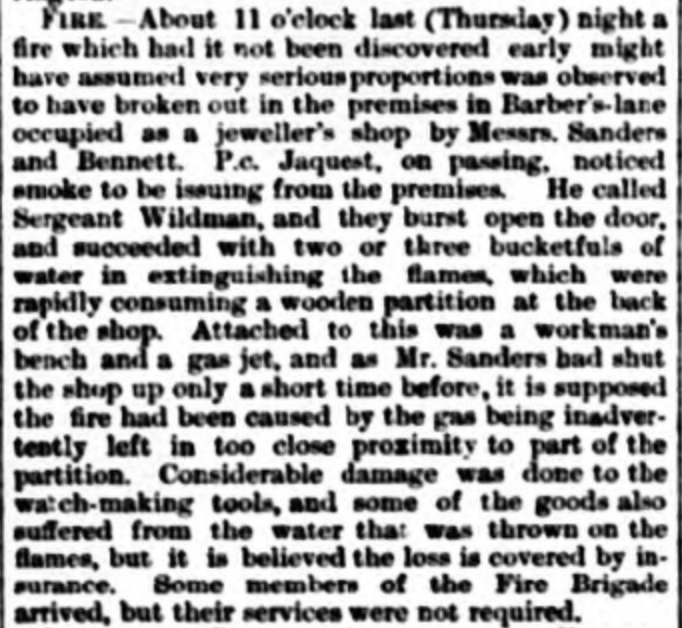
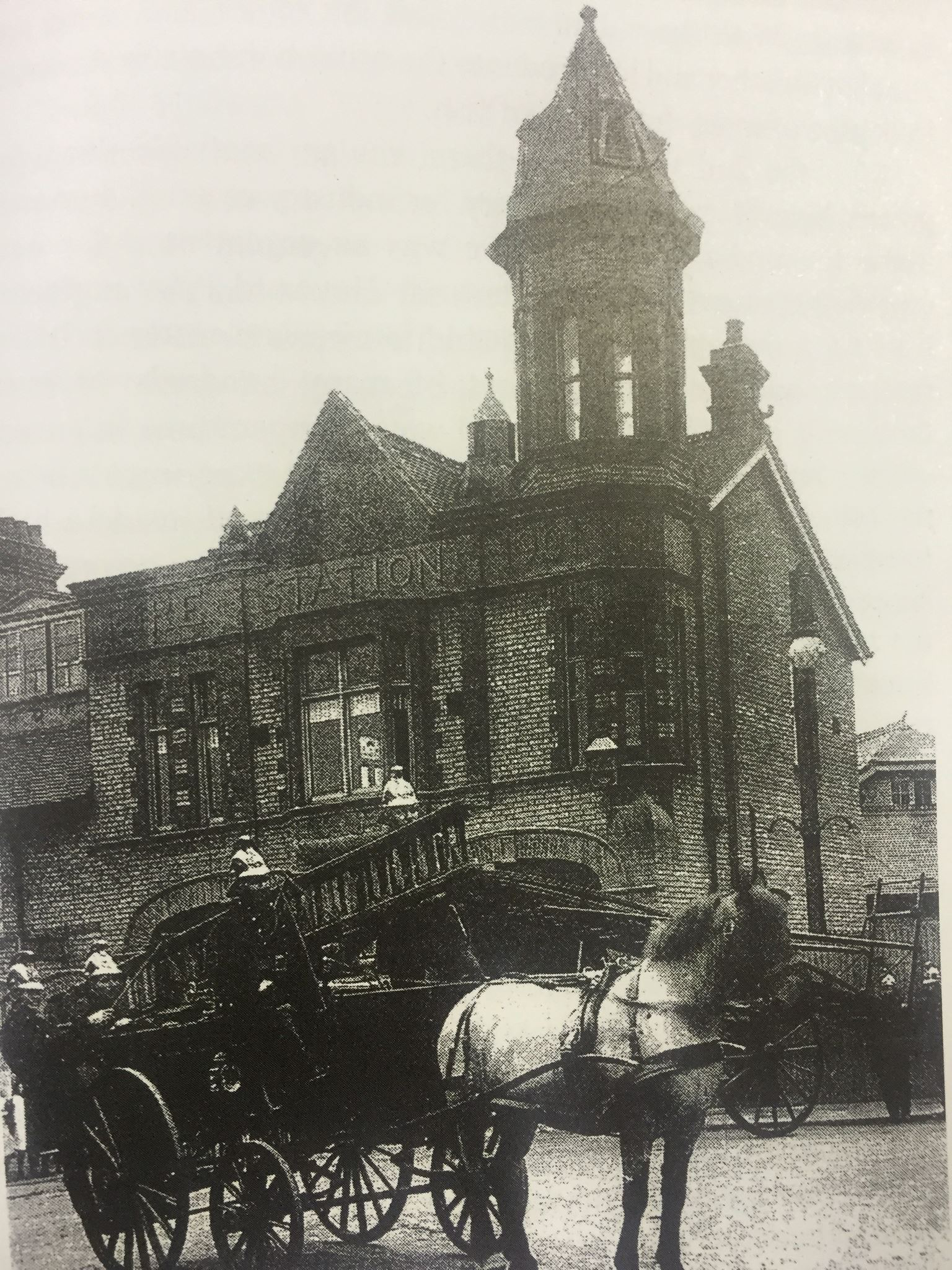
The committee meeting on the 11th December selected the teams to play against St. John’s College and Ashton Grammar School. The Sportsman newspaper advertised the game (15th December 1888 edition.)
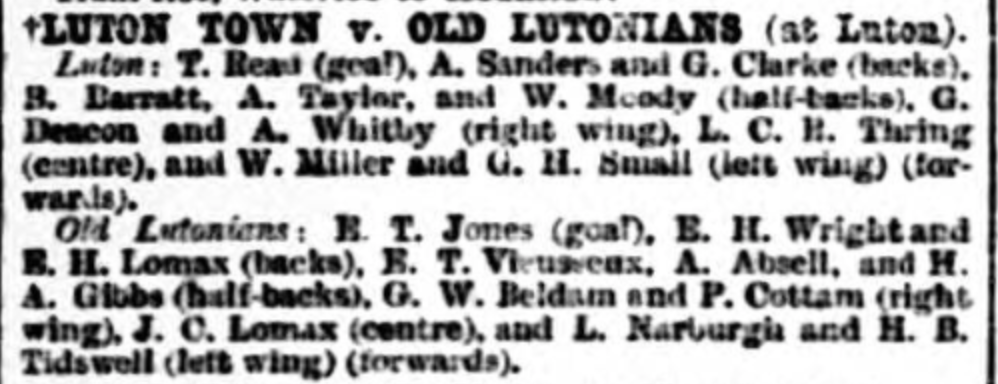
 The 15th December saw a return match between Luton Town and the Old Boy’s of St. John’s College. The Luton Times says
The 15th December saw a return match between Luton Town and the Old Boy’s of St. John’s College. The Luton Times says
“The Lomax brothers played for the college, but L.C.R. Thring scored the first four goals for the town, and one for each team was taken in the second half. The result was a win for the town by five goals to one”.
The 15th December 1888 saw the Luton Reporter on one of very few occasions thus far, reporting on the outside world of football. They mentioned that the Old Brightonians lost 5 2 at Great Marlow in the next round of the English Challenge Cup.
On Tuesday 18th December Luton Town met Mr Thring’s (Dunstable) Eleven, Ashton Grammar School.
“Played on the recreation ground, Dunstable on Thursday afternoon and resulted in a win for the visitors by six goals to one. The home team had J. Challen and A.G. Henfrey (Wellingborough Grammar School), but several of the Grammar school boys were also engaged, and the eleven was thereby considerably weakened. The visitors played well together, while several members of the Dunstable eleven showed conspicuously good play. The teams were as follows: Luton Town: H. Macartney, goal; A. Sanders and A. Martin, backs; J. Wright, H. Munroe and J. Moody, half backs; G. Deacon, centre; E. Wright and W. Miller, right; H. Whitby and A.E. Smart, left. Mr Thring’s eleven; A. Medcraft, goal; J. Clarke and E. Elliott, backs; T. Keeling L.C.R. Thring and E. Fox, half backs; A.G. Henfrey, centre; J.B. Challen and J.W. Thurnham, right; L.C.W. Thring and E. Gladwell, left, forwards”.
John Challen was an old friend of Thring’s from Wellingborough Grammar School who would go on to play for Wales in one match against England in March 1890.
Local football was getting stronger with more clubs appearing as the growth of the game continued. This weekend saw Montrose draw 2 2 with St. Alban’s second eleven. Luton Swifts were beating Excelsior on the moor, New Bedford Road, but the ball burst so the game was declared a draw. The Excelsior team was J. Groom, goal; P. Hughes and Webb, backs; A. Groom and F. Day, half backs; H. Warren, centre; G. Groom and A. Thwaites, right wing; E. Stonebridge and C. Pepper, left wing’.
The committee meeting on the 18th December tried to arrange some Boxing Day games with Unity and Bowes Park. Christmas saw a traditional football feast with the reserves and first team playing on two days, the reserves having a morning kick off. While J.C. Lomax’s appearance on the pitch is sporadic, he is writing to the committee every week.
The Luton Montrose game with Westminster swifts was advertised in the Sporting Life, 22nd December

 Wednesday the 26th December 1888 saw the Town play Unity.
Wednesday the 26th December 1888 saw the Town play Unity.
“Played in Dallow-lane on Boxing Day in presence of a good number of spectators. The home team was very weak, but they secured a victory by three goals to none. The game was well contested all through. The home team was as follows; T. Read, goal; A. Sanders and A. Martin, backs; J. Wright, W. Bird and A. Spacey, half backs; E. Wright, centre; J.C. Lomax and W. Miller, left; G. Deacon and H. Whitby, right”.
The Luton Times version of the game in Boxing day is as follows;
“The Luton Town played the Unity on Boxing Day, and a very good game was the result. The match was evenly contested. In the first half the Town scored once, Deacon shot the ball in, the goal keeper fisted it out, but Miller returned it at once. The visitors also got in two goals but both were disallowed for off-side. The second half the local team played up better, and scored two more goals. Whitby sending in a “hot ‘un” which went through at a terrific pace completely baffling the goalkeeper: this was followed soon after by a good shot by Edgar Wright, the Town winning a pleasant game by 3 goals to nil”. The newspaper goes on “The Unity F.C. (Messrs Tarn and Sons, Newington Causeway), played a match at Luton on Boxing Day with the Luton Town F.C., – and in the evening there was a smoking concert at the Midland Hotel, which went off with great success, the team contributing much to the enjoyment of the evening: especially in the recitation, “Kissing Cup’s race,” and songs by other members of the team were well received. A very pleasant evening was spent”.
Tarn and Sons appear to have been a firm of tanners in London.
 The last Saturday in 1888 saw defeats for both Town teams. The first was against Grosvenor College.
The last Saturday in 1888 saw defeats for both Town teams. The first was against Grosvenor College.
“This match was played on Saturday on the Town ground in Dallow-lane. Soon after the start, Waller, by some pretty passing, scored for the College. Mares shortly after scored another goal for the same team. The Town were unable to score, as the College had proved too strong for them, and the game ended in a victory for the Grosvenors by two goals to nil. The teams were as follows :- Luton Town: J. Smith, goal. Munroe and Humphreys, backs. G. Wright, Hoy, substitute, half backs. T. Brook-Knowles, centre; W.H. McNamara and W. Hills, right wing; H. Boxford and Brown, left wing, forwards. Grosvenor College: Whitehead, goal. W. King and G. Gurney, backs. H.W. Arnold, S.R. Harden and S. Brown, half backs. E.R. Arnold, centre; W.R. Waller and A.L. Arnold, right wing; R. Mares and Arnold, left wing”.
A weak Luton reserve team especially with a substitute at half back.
 Another Town team, presumably the first team, travelled to Wood Green against Bowes Park. The Luton Times
Another Town team, presumably the first team, travelled to Wood Green against Bowes Park. The Luton Times
“The ground was in very bad condition, the players on several occasions sticking in the mud; the home team seemed more at home on the ground than their opponents and won an evenly contested game by 3 goals to one”.
